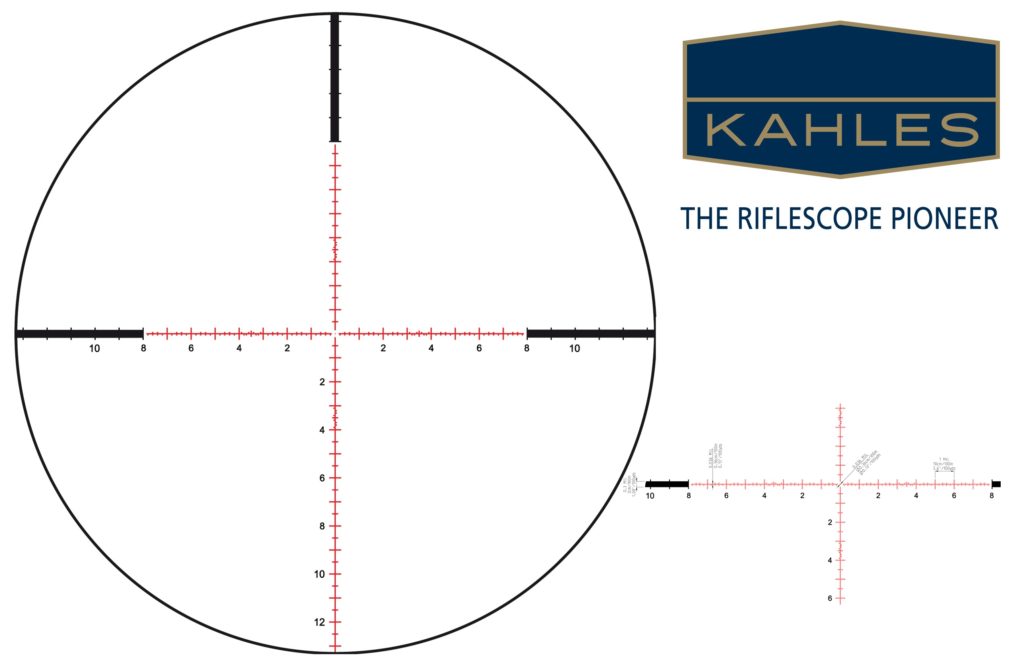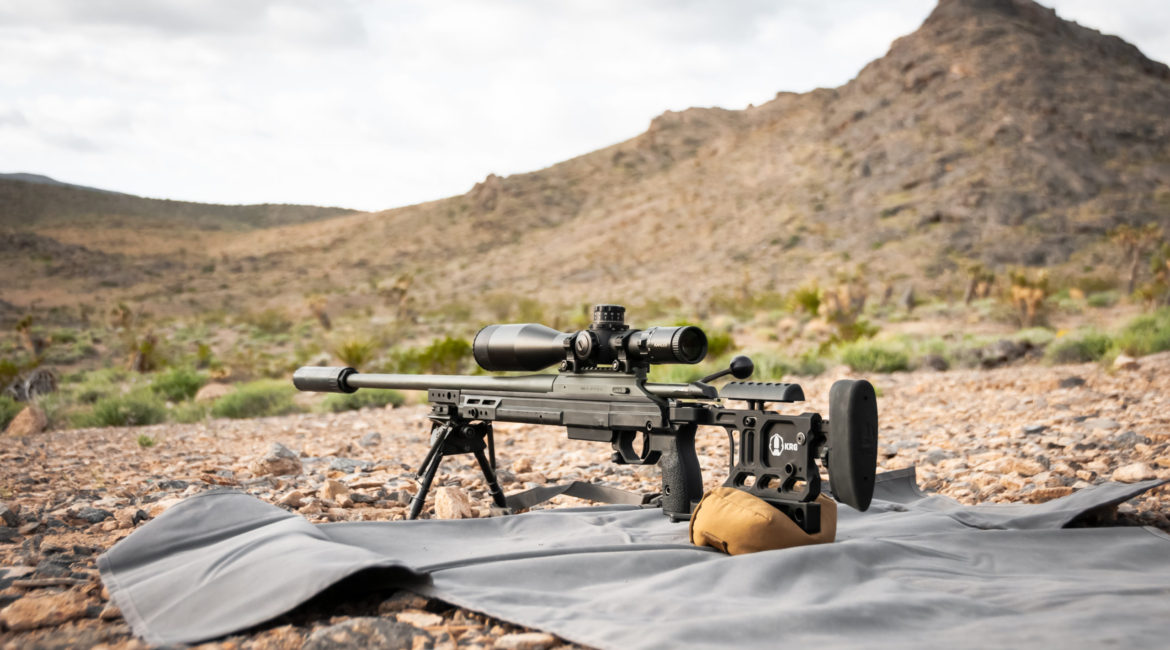Kahles K624i GIII SKMR reticle
I’ve been using the Kahles K624i on various rifles including my 6.5mm SAUM, 6.5mm Creedmoor and 6 Creedmoor this summer and despite the heat in Las Vegas I’ve managed to get a sizable number of rounds down range. The conditions are not ideal by any means and you are always dealing with heavy mirage. I do my best to leave the house before the sun rises, or wait until the evening and shoot during the last couple hours of sun light. It is not uncommon to step out of the truck and see 110 degrees on the Kestrel. The fall and winter is a welcome break from our long summers. Despite the conditions the K624i has performed incredibly well, allowing me to spot individual impacts on long range targets. When shooting in the evenings the clarity and light transmission allow me to shoot well after the sun dipped below the mountains.
One of the questions I am often asked about the K624i is in regard to the parallax adjustment. People ask if it was hard to get used to, or awkward to function. The knob is located on top of the erector housing at the base of the elevation knob, which is a unique feature to Kahles. I have always used scopes that had a left hand parallax knob and when I transitioned to the K624i I did not run into any issues. The design is intuitive and I never mistakenly turned the illumination knob (located on the left side of the erector housing) thinking it was the parallax. The updated knurling makes it very easy to grip and the tension is just right. The height of the parallax ring is high enough to easily access with little, to no interference from the top portion of your scope rings or mount. I have also noticed the numbering by distance is pretty accurate and I often dial the parallax without needing to look through the scope.

Where the parallax knob is traditionally located, is the reticle illumination knob. The K624i is equipped with a red illuminated reticle with adjustable intensity. To turn on the illumination you simply turn the knob located on the left hand side of the erector housing “clock wise” away from the off position. To increase the intensity you continue turning “clock wise”. I like that the entire SKMR reticle is lit and not just a portion of it.
I have not used many scopes that had a zero stop. I do like the idea of one, but sometimes found them to be a bit of a burden. When zeroing your rifle you would dial your adjustments and depending on the scope you were using, you would have to remove the turret and set the stop. Sometimes you had to utilize an under turret or an inner screw you adjusted. What I like about the zero stop on the Kahles is that you do not remove the turret, just simply loosen two screws and turn the knob clockwise until it stops. Once you have done this you line up the number zero with the index mark on the scope body and tighten the screws. The turret automatically gives you 0.3 to 0.4 MRAD below your zero. Your POA/POI is maintained while you do this. The feature is nice when getting your riflescope set up out in the desert. I also enjoy the second rotation indicator located on the top of the elevation turret. This is the first scope I have bought that has this feature. The red indicator will rise above the turret once you dial past the first revolution. When the indicator is in the up position you know to reference the second line of numbers on the turret to read how much elevation you are dialing into the scope. The indicator is a bright red which makes it easy to see and it rises above the turret enough to easily feel it if you need to. The elevation knob adjusts in 0.1 MRAD increments and the clicks are very deliberate.
The windage knob on the K624i features a rotation stop. The windage rotation stop keeps you from over dialing and mistakenly ending up one rotation off. I do not often dial for wind but really like the feature they incorporated. The stop is also very simple to set, you just dial your adjustments to line up your POA/POI and loosen two screws. Then you just line up the number zero with the index mark on the scope body and tighten the screws. The rotation stop then sets itself and does not require any additional steps. The windage knob also adjusts in 0.1 MRAD increments and has the same feel and tension as the elevation knob. I really like the feel of the click adjustments on both knobs. They have zero movement or flex and are not easily moved unless done so deliberately. The K624i does not incorporate turret locks and that might be a letdown for some but I’m okay not having locking turrets.

I have found the eye box to be forgiving with a generous eye relief. The eye relief is not as generous as a Bushnell XRS but still offers plenty of space to avoid “the mark of the magnum”. The fast turn reticle focus (diopter adjustment) located around the ocular lens is fast and easy to adjust. This is not something I need to adjust often and have noticed it does a good job of staying in place. The adjustment ring has a triangle on it, which makes it easy to use a witness mark, ensuring your diopter setting has not moved. Located in the same region is the magnification ring, which allows you to adjust for any magnification between 6x and 24x. The tension to move the ring offers enough resistance that it will not likely move inadvertently but easy enough that going from 6x to 24x is not a huge burden. This is aided by the knurling on the magnification ring and extra raised bevel which works like a low profile “cat tail”.
New for 2015 is the SKMR reticle located on the first focal plane (FFP). A scope with FFP is nice because your reticle subtensions are maintained throughout the magnification range, as opposed to a second focal plane (SFP) scope where your reticle subtensions change depending on what magnification you are using. The SKMR reticle stood out to me because of the 0.2 MRAD marks on the horizontal stadia line. This offers very precise points of aim for holding windage. The reticle thickness is also thin when using it at 24x magnification (0.036 MRAD). The floating dot in the center of the reticle is great for shooting groups and provides an excellent aiming point. The reticle also features 0.1 MRAD references to aid in range estimation, which is important because when targets are far away a small miscalculation can lead to a large error that will cause you to miss the target. The references are incorporated into the reticle very well and provide you with a lot of tools while keeping the reticle simple and minimally obstruct the view down range. As I mentioned earlier the SKMR can be illuminated and is controlled by the knob on the left hand side of the erector housing.

I have been impressed with the quality of the glass found in Kahles scopes. The K624i boasts 95.2% light transmission. During a recent side-by-side comparison I found the glass to be comparable to a Schmidt & Bender 5-20x50mm Ultra Short. When comparing to a Vortex Razor II 4.5-27x56mm, the most noticeable thing is the increased field of view with the Kahles. I also noticed the K624i was brighter to my eye. This was a lot more noticeable when shooting in diminished light before sunrise or after sunset.
The Kahles K624i is a great value from a storied optics brand. Many of the top tier European scopes are priced in the high $3,000’s with some at, or over the $4,000 mark. This is a substantial amount of money to invest in a riflescope. The Kahles K624i surprisingly comes in at $2,990. The SKMR reticle (or SKMR 2 if you prefer) has great features for the long-range shooter, hunter or competitor. The ease of the zero stop and windage rotation features further make these scopes very appealing.

